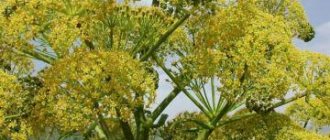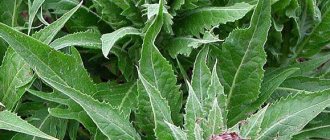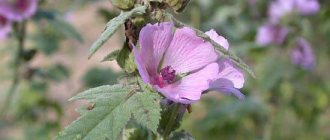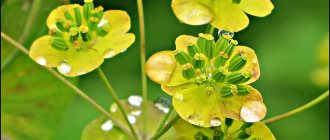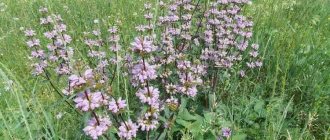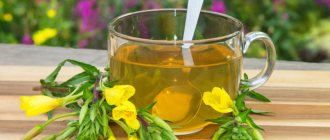What kind of plant is this?
Ferula jungarica is the scientific name of the plant, which is better known as omik.
Its main growing area is some areas of Altai. The height of the plant reaches three meters, and visually it resembles flowering dill (omik blooms with yellow umbrellas). Ferula is unpretentious and can grow both near bushes and in dry areas. The plant got its name from its flexible stem, which in ancient times was used as a rod (“ferula”). The smell of omik is reminiscent of pine needles. The main reason for this aroma is the increased content of essential oils. The upper part of the ferula is not considered medicinal. The entire concentration of useful elements is in the roots. It is the rhizomes of the plant that become the basis for the preparation of tinctures for rubbing or ingestion, as well as the production of numerous dietary supplements or other pharmaceutical preparations.
Beneficial features
Ferula jungarica is widely used to treat many diseases. The plant has anti-cancer properties and helps normalize the functioning of the gastrointestinal tract. Omics contains more than 120 elements that belong to the category of medicinal components.
Ferula jungarica has the following beneficial properties:
- stimulation of the immune system;
- prevention of stone formation;
- antioxidant property;
- decreased blood sugar levels;
- resorption of hematomas and elimination of the consequences of skin injuries;
- antihistamine effect;
- antitumor effect;
- diuretic property;
- lowering blood cholesterol levels;
- elimination of the consequences of a stroke;
- general tonic effect;
- antispasmodic effect;
- anticonvulsant property;
- stopping the growth of malignant and benign neoplasms;
- cleansing the body of toxins and waste;
- treatment and prevention of colds;
- strengthening the heart muscle and the cardiovascular system as a whole;
- anti-inflammatory effect;
- improving the quality of life (when using omica root to prevent dysfunction of internal organs).
Ferula is widely used in gynecology and urology. When using remedies based on this plant as an addition to the main course of treatment, the tendency to recovery is noticeably accelerated. In women, omik helps cure mastopathy, fibroids, endometritis, cycle disorders, and diseases of the reproductive organs. In men, the plant helps improve potency and speeds up the treatment of prostate adenoma.
Children prone to frequent colds or diagnosed with abnormalities in the functioning of the respiratory system are recommended to take ferula in the form of decoctions or compresses. Thanks to its ability to improve immunity and normalize the functioning of internal systems, the plant will increase the child’s health level and have a preventive effect on the growing body.
Useful properties of ferula
Only a few plant species are known to provide benefits. For example, Ferula Djungarian has the following healing properties:
- antitumor;
- antispasmodic;
- bactericidal;
- painkiller;
- antioxidant;
- cardiotonic;
- cleansing;
- immunostimulating;
- anti-inflammatory;
- antiparasitic;
- absorbable;
- choleretic.
Are there any harms and contraindications?
The use of omics for medicinal purposes has some peculiarities. In the first days of taking the plant in any form, an exacerbation of symptoms may occur. Some patients note the appearance of diarrhea and discomfort in the genitourinary system. Such conditions are not side effects.
These signs accompany the beginning of the healing process. If symptoms do not go away within two days, then you should consult a doctor and stop taking medications based on Ferula Dzungarian.
The following conditions are contraindications for taking omics-based drugs:
- If you have high blood pressure, Omic root should not be taken orally;
- in case of hypertension, omics-based drugs are used with caution, and if there is an exacerbation of the disease, they should be abandoned;
- children under 13 years of age (before using omics as a means of treating a specific disease in children, it is recommended to discuss this method with a doctor in advance);
- pregnancy and breastfeeding period.
Overdose or improper use of ferula can have a negative impact on the functioning of the genitourinary system. When treating diseases of this category, the plant is also recommended to be used with caution. Omic has diuretic properties. If a negative reaction of the skin or body occurs, the use of ferula-based products should be discontinued.
Omik, or Djungarian ferula (Ferula soongarica)
Omik, also called Ferula jungarica, is a perennial herbaceous plant of the Apiaceae family with a stem reaching 4 meters in height. The leaves are trifoliate-dissected, predominantly basal, collected in a rosette. Small, less than a centimeter in diameter, flowers of light shades of yellow are collected in large paniculate inflorescences. The omika fruit is flat, compressed, oval in shape. This plant blooms in the second half of spring and ripens in the last days of the same period.
Omic is a predominantly Asian plant, most often found in the countries of this region: India, Iran, Kazakhstan, Iran, China and Mongolia. Also found in some regions of Russia. As a rule, it grows among other shrubs.
Pour 4 tablespoons of crushed root into 300-350 ml of boiling water, leave for 1 hour, then put on low heat and boil for 20-25 minutes. After cooling the resulting product to room temperature, pour it into a separate container, squeezing out the raw materials there, which then must be used again, mixing both resulting decoctions. The product is added to the bath at the rate of 10 ml of decoction per 1 kg of person’s weight.
Omic tincture and decoction
An alcoholic tincture of Ferula Dzungarian root is used for the complex treatment of diabetes mellitus, diseases of the joints and spine, and diseases of the nervous system. It stimulates appetite, normalizes metabolism and is an excellent prophylactic agent that prevents the appearance of tumors.
To prepare it, you need to pour 60 g of omik roots into 500 ml of vodka. The product must be infused for 14 days in a dry, dark place, shaking the container daily to ensure uniform extraction of the active ingredients. Afterwards, the tincture should be strained and poured into a dark glass container and stored in the refrigerator. It should be taken orally, starting with 1 drop twice a day an hour before meals. Increasing the dosage by 1 drop per day, you need to bring it to 20 drops at a time. After this, the dose should be reduced in the opposite direction (first 20 drops, the next day - 19, etc.). The tincture can be used externally to treat painful areas (usually 15 drops of the product are enough for this).
To prepare a water decoction you need 4 tbsp. l. crushed dried ferula root, pour 0.6 liters of boiling water and keep on low heat for 30 minutes. After cooling, the broth should be strained and taken 15 ml before bed every day for 10 days. This remedy strengthens blood vessels, improves heart function, eliminates skin diseases, inflammatory processes in joints and muscles. Its intake also has a beneficial effect on the functioning of the genitourinary system (especially with prostatitis, cystitis and kidney inflammation). Omic decoction also normalizes blood pressure and thins the blood, preventing the formation of blood clots.
Dosage forms
Ferula Djungarian is sold both in the form of dried root and is included in many pharmaceutical products. The most common forms of release are tinctures and creams. When studying the range of products, it is important to take into account the different names of the plant. Manufacturers can specify any of the known options, which often causes difficulties for buyers.
Forms of release of products based on Ferula Djungarian:
- omika root in bags (ferula jungarica);
- galbanum essential oil (one of the names of ferula);
- tincture of omik (ferula dzungarian);
- Ferula Djungarian is included in some creams intended for the treatment of mastopathy, osteochondrosis or hemorrhoids (for example, different types of Fitol cream).
Instructions for use
Recipes that do not include alcohol are universal and suitable for use by patients of any age, with the exception of children under 13 years of age. Products containing alcohol or alcohol should only be used after consultation with a specialist. The course of treatment depends on the degree of development of the disease and the type of prescription. Rubbing in tinctures is carried out for at least 20 days, and decoctions are used in a course, the average duration of which is 30 days.
For adults
Omic root tincture:
- The crushed root of the plant is poured with vodka (for 30 g of root you will need 500 ml of vodka).
- The preparation must be infused for at least ten days (the best option is two weeks).
- You should take the tincture on the first day, one drop an hour before meals, twice a day, and then the dosage is increased daily by one drop.
- On the twentieth day, the dosage should be 20 drops twice a day an hour before meals.
Decoction:
- Pour 30 g of plant root with 600 ml of boiling water.
- Boil the preparation for 20 minutes.
- For ten days, take one tablespoon before bed.
Ferula root ointment:
- Mix liquid honey and apple cider vinegar in one container (to three parts honey, take seven parts vinegar).
- Mix the preparation with three tablespoons of ferula root.
- Place the workpiece in a dark and cool place for two weeks.
- The mixture must be shaken periodically.
- After infusion, the product is ready for use as an ointment for skin diseases or injuries.
For children
Cake compresses:
- Prepare the decoction according to the traditional recipe (pour boiling water over the omik root and boil for twenty minutes over low heat).
- Strain the broth.
- Apply the cake several times a day to the affected area (for example, for injuries, sprains, on the chest in the presence of colds or respiratory diseases).
- Repeat the procedure for at least seven days.
During pregnancy and breastfeeding, the use of ferula decoctions and tinctures is strictly prohibited. The plant has abortifacient properties, which can negatively affect the gestation of the fetus and the health of the infant. It is also better to avoid compresses or other methods of using omics. Ferula and all products based on it are contraindicated in children under 13 years of age.
For adults
Omic root tincture:
- The crushed root of the plant is poured with vodka (for 30 g of root you will need 500 ml of vodka).
- The preparation must be infused for at least ten days (the best option is two weeks).
- You should take the tincture on the first day, one drop an hour before meals, twice a day, and then the dosage is increased daily by one drop.
- On the twentieth day, the dosage should be 20 drops twice a day an hour before meals.
We suggest you read: Inflammation of the epididymis in men, treatment
For children
Mode of application
Based on the root of the plant, decoctions, infusions, and tinctures are prepared for internal and external use:
- Decoction. Pour 20 g of plant roots into 0.6 liters of boiling water and leave on low heat for a quarter of an hour. Use warm, 1 tbsp. l. before going to bed. Course – 9 days.
- Tincture. For 50 g of dry plant you will need 0.5 liters of vodka. Leave for 3 weeks, shaking occasionally. Take 1 tsp, diluted in 50 ml of water in 3-4 doses, half an hour before meals. If necessary, take a break for a week, then repeat the treatment for 2 weeks, increasing the dose to 1 tbsp. l. Also used as a rub for sore spots, lubricate tumors, wounds, ulcers, abscesses, make compresses with an insulated bandage.
- Tincture. The recipe is popular among the population of Altai for various diseases, primarily for benign and malignant diseases of the gastrointestinal tract. For 30 g of dry mixture, take 0.5 liters of vodka, leave for 2 weeks, and squeeze out. Take 1 tsp. in 2 doses half an hour before meals. A popular and safe method of administration is the Gorka drip regimen. On the first day, take 1 drop, increasing the dose by a drop daily. Upon reaching 20 drops, reduce the dose by a drop daily. Repeated courses can be taken at 40 drops. The breaks between them are 10 days. The tincture is diluted in boiled warm water to prevent the gastrointestinal tract from destruction.
Description and composition
Ferula during flowering looks like dill. The stem grows up to 1.7 m. It has a loosely branched appearance. The leaves are very large, can grow up to 80 cm in length, and have a dissected, pinnate shape. Includes 5-6 linear beats. The foliage is a bright green shade, smooth, shiny and soft. The inflorescences are large umbrellas of a yellowish tint.
The plant can live in one place for up to 10 years, bloom and bear fruit many times. Usually found in Kazakhstan, China, Mongolia, as well as in western Siberia and Altai. It is completely unpretentious. As a rule, the culture grows in deserts, steppes, on the outskirts of forests, near mountains and plains.
Ferula dzungarian is also called omik. The scientific name is translated from Latin as “rods”. This is due to the fact that the stems are very flexible. The smell is similar to pine needles. This is due to the fact that the plant contains a large amount of essential oils. The above-ground part is not medicinal. The maximum amount of useful substances is collected in the root.
There are various vitamins, microelements, resins and other useful compounds. That is why the underground part of the plant is used to prepare various decoctions for internal and external use. It is also included in various pharmaceutical preparations and dietary supplements.
https://www.youtube.com/watch?v=E4KyJPAhBEw
The root thickens in the soil. It gradually increases with age and contains a lot of juice, which is called milky. The most valuable is the white juice, which has a pungent aroma - this is due to the high concentration of gum and resins. Ferula begins to become active in early spring, as soon as the snow melts, while most other plants are still in the dormant stage.
At the pharmacy you can purchase both the dried root separately and various pharmaceutical products. The most popular are creams and tinctures. The root itself is sold separately in bags. The creams are intended for the treatment of hemorrhoids, osteochondrosis, and mastopathy.
Beneficial properties and contraindications to the use of asafoetida
Ferula dzungarian is also called omik. The scientific name is translated from Latin as “rods”. This is due to the fact that the stems are very flexible. The smell is similar to pine needles. This is due to the fact that the plant contains a large amount of essential oils. The above-ground part is not medicinal. The maximum amount of useful substances is collected in the root.
There are various vitamins, microelements, resins and other useful compounds. That is why the underground part of the plant is used to prepare various decoctions for internal and external use. It is also included in various pharmaceutical preparations and dietary supplements.
Beneficial properties and contraindications to the use of asafoetida
Ferula grows up to three meters in height. During flowering it is very similar to giant dill. The leaves are dissected, large, bright green, the stem is flexible. The flowers are yellow, collected in umbrellas, they bloom in May-June.
The following elements were found in the composition:
- ferulic acid;
- sesquiterpenes;
- essential oils;
- terpenes;
- coumarins;
- carbon oxides.
Ferula stinking medicinal properties and contraindications
Syn: asafoetida, hing, ilan, asmargok, stinking resin, bad spirit, damn feces.
Ferula stinking or asafoetida is a perennial herbaceous plant with umbellate inflorescences. It is used in cooking as a spice, and in folk medicine to combat coughs, flatulence and cramps.
Flower formula
Ferula stinking flower formula: *H(5-0)L5T5P(2)-.
In medicine
The plant is not included in the State Pharmacopoeia of the Russian Federation and is not used by official medicine.
Asafoetida is a spice obtained from the plant Ferula assa-foetida of the Apiaceae family.
The spice is extracted from the dried milky sap (latex) of the plant root, which is a brown rubbery mass. Asafoetida reaches the counter either in the form of dried pure resin (latex), or in the form of so-called compounded or mixed asafoetida, which consists of a fine powder of ground latex mixed with rice flour and gum arabic. In this form, asafoetida does not stick together and is easy to dose. At the same time, compounded asafoetida quickly loses its aroma, and the resin can be stored for many years.
The beneficial properties of asafoetida were known in ancient India, Iran, Pakistan and other countries. Mention of this spice can be found in the Charaka Samhita, one of the most important treatises of Ayurveda. There, asafoetida is located in the section of antispasmodics and painkillers. Treatment with asafoetida is still appropriate today in cases of diseases of the gastrointestinal tract (especially the intestines), nervous system and respiratory organs.
For bloating, asafoetida has a carminative effect, for respiratory diseases it has an expectorant effect, and has a relaxing effect on the nervous system, helping with convulsions. For medical purposes, it is better to use asafoetida resin (lat. Gummi-resina Assa foetida) - the frozen juice of the plant root, from which emulsions and tinctures are made, although the use of asafoetida in powder form is also common.
Contraindications and side effects
Contraindications for treatment with asafoetida. People with an individual intolerance to this spice should not use asafoetida and products based on it, during pregnancy and breastfeeding, at elevated body temperature, and also with increased stomach acidity.
In cosmetology
Cosmetics containing ferulic acid, obtained from asafoetida and other umbelliferous plants, are widely known. Ferulic acid peels cleanse skin impurities, remove toxins and help smooth out wrinkles.
In cooking
In cooking, asafoetida is used as a seasoning for many dishes.
It has a sharp, pungent taste and smell, similar to a mixture of the taste of garlic and onion at the same time. But unlike these spices, there is no unpleasant odor left after eating asafoetida. It is often added to legume dishes - due to its carminative properties, asafoetida helps to easily digest such dishes, gently relieving bloating and other manifestations of indigestion. Due to its ability to have a beneficial effect on digestion, asafoetida is also used in “heavy” dishes, such as soups or lamb stews. Ferula (asafetida) goes well with the following spices: ginger, turmeric, black mustard and cumin. Asafoetida powder will reveal its taste better and softer if it, together with other spices, is slightly fried in oil before adding to the dish.
Omic tincture and decoction
An alcoholic tincture of Ferula Dzungarian root is used for the complex treatment of diabetes mellitus, diseases of the joints and spine, and diseases of the nervous system. It stimulates appetite, normalizes metabolism and is an excellent prophylactic agent that prevents the appearance of tumors.
To prepare it, you need to pour 60 g of omik roots into 500 ml of vodka. The product must be infused for 14 days in a dry, dark place, shaking the container daily to ensure uniform extraction of the active ingredients. Afterwards, the tincture should be strained and poured into a dark glass container and stored in the refrigerator.
It should be taken orally, starting with 1 drop twice a day an hour before meals. Increasing the dosage by 1 drop per day, you need to bring it to 20 drops at a time. After this, the dose should be reduced in the opposite direction (first 20 drops, the next day - 19, etc.). The tincture can be used externally to treat painful areas (usually 15 drops of the product are enough for this).
To prepare a water decoction you need 4 tbsp. l. crushed dried ferula root, pour 0.6 liters of boiling water and keep on low heat for 30 minutes. After cooling, the broth should be strained and taken 15 ml before bed every day for 10 days. This remedy strengthens blood vessels, improves heart function, eliminates skin diseases, inflammatory processes in joints and muscles.
Looking for yellow umbrellas
The plant got its name “ferula” for its flexible and long stems. They were once used as rods, that is, ferula, to punish naughty children and careless students. And the Dzungarian plain is a plain that covers both Altai and China, which are the birthplace of the plant.
The root exudes juice, named for its milky hue. The essential oils contained in it are the reason for such a strong smell. But here's what's interesting. The sap of the roots, hardened and emitting a foul aroma, is white and is the most valuable in the plant #8212; it contains gums and resins.
But the roots boast a list of substances of 122 items, including various minerals, acids and vitamins. But the most valuable thing is scopoletin (coumarin). A substance that has an antitumor effect and normalizes blood sugar levels. This means that in addition to the fungus, humanity now has another assistant in the fight against cancer.
And also antihistamine, antispasmodic, choleretic, antiseptic and antitumor. This is such a universal remedy.
I have slightly different problems than Yakovlev. These are hemorrhoids, liver, urethritis and male disease prostatitis. A decoction of omika roots helped. Now I feel rejuvenated and healthy. Even men's health has improved.
I also had an injury - my ribs were broken. On Yakovlev’s advice, I began to rub myself with a decoction of the root. Just three weeks and the pain disappeared.
So what is included in the list of diseases that the miracle drug works on?
With such a list of diseases, a question arises. Is Ferula Djungarian really safe? Are there any contraindications for use? If yes, which ones? Yes, if there is individual intolerance, the woman is in an interesting position or is breastfeeding the baby.
For the purpose of treatment, we present non-alcoholic recipes, the main component of which is ferula root. Its use will be safe if the dosage is not exceeded.
Over low heat, boil the dry crushed root (3 tbsp) in 600 ml of water for 20 minutes, covering with a lid.
Drink a tablespoon of warm decoction before bed for 1.5 weeks.
The cake remaining after straining can be used for compresses on sore joints, back, legs, shoulders, etc.
Mix apple cider vinegar and honey in a ratio of 7:3 and pour 3-4 tablespoons of this solution. roots. Leave for 2 weeks, shaking the substance from time to time.
Helps with skin diseases.
Use alternately. One day - compresses, the next day - add to the bath along with a decoction of chamomile, horsetail, celandine, burdock and violet roots (200 grams of a mixture of herbs per 3 liters of boiling water). The duration of the fit bath is 15 minutes with a temperature of up to 40 0 . After the bath, go to bed.
Do not confuse unpleasant symptoms that may occur during treatment with intolerance. Sometimes the body reacts this way to being freed from illness.
- Treatment of cystitis may be accompanied by changes in the color and smell of urine and frequent urination.
- If the stomach is treated, vomiting, nausea, even constipation or diarrhea are possible.
- For high blood pressure, Omic should be used externally.
Listen to your body. If you sense something is wrong, continue treatment. If the symptoms do not disappear or become more acute, then individual intolerance occurs.
Looking for yellow umbrellas
Ferula jungarica (root)
3662
Recipes for preparing Ferula Djungarian roots (omica)
1.
Alcohol tincture of omika roots.
Helps in the treatment of arthrosis, gout, osteochondrosis, polyarthritis, radiculitis
and
intervertebral hernia
.
For the best treatment effect, it is advisable to combine external and internal use. It also helps with diabetes, disorders of appetite, digestion and metabolism, multiple sclerosis, atherosclerosis, neuroses
and
epilepsy
, as well as for the treatment and prevention
of tumors
.
Cleanses blood vessels in thrombophlebitis
, normalizes blood pressure in
hypertension,
helps with
inflammatory diseases of the gastrointestinal tract
.
Useful for prostatitis
.
To prepare the tincture, you need to pour 3-4 tablespoons of the roots with 0.5 liters of 40% alcohol. Infuse for 1.5-2 weeks in a dark place, without access to sunlight, after the expiration of the period, strain. Take orally twice a day an hour before meals, while at the very first dose the dosage is 1 drop of tincture, the next time it increases to 2; Thus, it is necessary to reach a dosage of 20 drops and maintain it for about a month, then return to the original portion using the same scheme. External use of Omic tincture consists of rubbing 10-15 drops of it into painful areas, which must first be massaged and rubbed.
2.
Omika root decoction.
This remedy treats vitiligo, osteochondrosis, radiculitis, gout and intervertebral hernia.
.
It also stimulates the heart, helps with seizures, thrombophlebitis, hypertension, kidney diseases, genitourinary system
and
prostatitis
.
In addition, it is recommended in the treatment of lung diseases: tuberculosis, pneumonia, bronchitis
and
bronchial asthma
.
After grinding 2-3 tablespoons of dry raw materials, pour 0.5-0.6 liters of boiling water over them and place on low heat. Boil in a sealed container for about half an hour, then remove, cool and strain. You need to drink the decoction warm, 1 tablespoon once a day before bed. The standard course of treatment is 1.5 weeks, extended if necessary.
3.
External decoction of omika.
Used in the form of baths to treat metabolic disorders, diabetes, thrombophlebitis
, as well as diseases of the joints and back.
Pour 4 tablespoons of crushed root into 300-350 ml of boiling water, leave for 1 hour, then put on low heat and boil for 20-25 minutes. After cooling the resulting product to room temperature, pour it into a separate container, squeezing out the raw materials there, which then must be used again, mixing both resulting decoctions. The product is added to the bath at the rate of 10 ml of decoction per 1 kg of person’s weight.
Contraindications and overdose
Omic is a medicinal but poisonous plant. Therefore, when using it, it is very important to follow the dosage and not exceed it, as you can get poisoned. In therapeutic doses, Ferula Dzungarian does not cause harm to the human body (with the exception of some conditions in which its use is prohibited). Contraindications to taking medications based on this plant are:
- the patient's age is under 18 years;
- pregnancy and breastfeeding;
- high body temperature;
- pustular rashes on the skin;
- malignant oncological processes (taking into account the antitumor effect of the plant, the possibility of its use in each specific case should be checked with an oncologist);
- increased stomach acidity;
- individual intolerance, tendency to allergic reactions.
In case of an overdose, profuse salivation, nausea, and burning pain in the abdominal area may occur. Then the pupils dilate. In case of severe poisoning, convulsions may occur. To avoid serious consequences, when these symptoms appear, you should immediately rinse your stomach with clean water, do a siphon enema and call an ambulance.
Ferula jungarica is a large perennial herbaceous plant that is actively used for preparing medicines at home. The manufactured drugs help with eye diseases, conjunctivitis, varicose veins and joint problems. It must be taken into account that omik is a poisonous plant. In small doses it has a medicinal effect, but if you do not follow the instructions, the drug can cause harm and lead to poisoning.
Healing properties of Ferula Djungarian
The main beneficial properties of this plant include the following:
- pronounced anti-cancer effect;
- stimulation of the immune system;
- antioxidant effect, prevention of early aging;
- decrease in sugar concentration;
- antihistamine effect;
- mild diuretic effect;
- general tonic effect;
- reducing blood cholesterol levels;
- elimination of spasms and pain;
- elimination of inflammatory processes;
- preventing colds and viral diseases by strengthening the immune system.
The products remove toxic substances and wastes that are formed as a result of the activity of parasites and prevent their further reproduction.
Applications and recipes with Ferula Dzungarian
Below is the most common recipe, which is often used for worms, helminths and other parasites in the body:
- take 4 large spoons of crushed root and place in a glass container;
- add half a liter of vodka;
- leave the product in a dark place with the lid closed for two weeks, shaking the container every day;
- take the strained drug 10 drops per day for three weeks, after which you should take a week break and repeat the course.
There is also a healing decoction that can be taken orally and also used as a lotion. Grind three tablespoons of root and cook for 30 minutes in 0.5 liters of boiling water. After this, the cooled broth is taken one large spoon every day at night. Treatment should be carried out for 10 days, during which time the parasites should cease their vital activity.
During the treatment period, it is recommended to drink a lot of water to eliminate the symptoms of intoxication. Ferula can be taken as a primary or additional remedy, in combination with other drugs against parasites.
Ferula has a powerful effect not only against parasitic diseases. It is advisable to use it for hemorrhoids and osteochondrosis. In this case, patients can purchase a special ointment based on this component, which is applied to problem areas several times a day. As a result, it is possible to eliminate the inflammatory process and reduce pain, and restore the normal process of blood movement.
Contraindications
Ferula Djungarian tincture is an effective and safe natural remedy, but in some cases it is better to refrain from using it. The following are contraindications to treatment with this herb:
- high body temperature and acute inflammatory processes in the body, including colds and viral diseases (in this case, you should wait until recovery);
- high degree of stomach acidity, problems with the digestive system (peptic ulcer, gastritis and other diseases require prior consultation with a gastroenterologist);
- increased sensitivity to the plant and medications based on it, tendency to allergic reactions;
- period of pregnancy and breastfeeding.
Despite the fact that ferula has an antitumor effect, before using it in the case of oncology, you should consult a doctor, since therapy is individual in each case. The drug should be taken with caution in childhood.
Side effects when taking the drug include nausea and vomiting, increased salivation, headache, dilated pupils, signs of an allergic reaction (rash, itching, swelling of the skin). Treatment in this case consists of calling an ambulance and gastric lavage.
Similar symptoms can occur when the permissible dosage is exceeded. If you doubt the advisability of using the product, first consult with your doctor.
